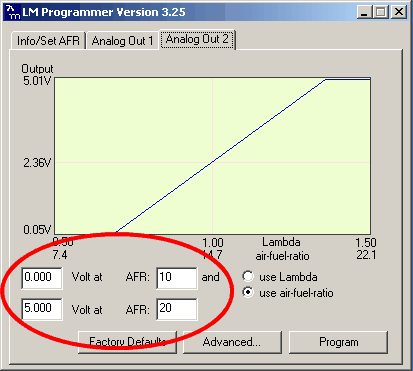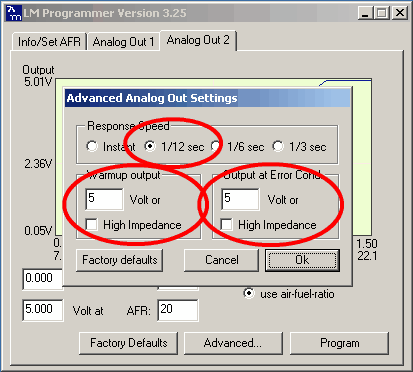It is possible to use an aftermarket wideband lambda meter to provide an accurate lambda reading to the ECU. Note that a wideband lambda meter consists of a oxygen sensor and controller - both components need to be used in order to get a wideband lambda reading.
Installation
You will need a wideband meter which has an analog output, preferably 0-5V with a linear relationship between voltage and lambda. The wideband meter analog output is then wired into an used ECU input. Available ECU inputs are:
| • | SO2 (secondary o2 sensor). Secondary oxygen sensor must be disabled and disconnected. Note that it is not recommended to use this pin for wideband input as the ECU internally limits the voltage so that an accurate wideband reading cannot be made. |
| • | EGRL (EGR lift). Requires the use of an ECU pin and wire. |
| • | ECT2 (Second water temperature sensor). The Second ECT sensor must be disabled and the factory pin must be removed from the ECU connector. |
| • | ELD (Electrical Load). ELD must be disabled and the factory pin must be removed from the ECU connector. |
See ECU Connectors for information about locating the correct ECU pin.
Grounding
In order to prevent ground loops, it is critical that the lambda meter uses the same ground as the ECU, for both the power and analog output sections of the lambda meter. For the K-Series engine, the correct ground point to use is G101, located on the intake manifold. Do not ground the ECU or lambda meter to any other points, or share the lambda meter ground wire with any other devices.
Settings
Wideband input settings are found under Closed loop parameters
![]()
Select the analog input pin.
![]()
It is possible to compensate for a voltage difference between the ECU and lambda meter. Note that in most cases this means that you have a ground offset problem, and will not get accurate readings unless the grounds are changed. If you need to enter an offset value, this means you have a ground problem which should be fixed.

The voltage from the wideband is translated to the lambda reading. Normally your lambda meter documentation will have an output graph which shows you which values to use. If you meter has more than two voltage/lambda pairs, it may not have a linear output, and cannot be used.
PLX Lambda Meters
PLX lambda meters all provide a 0V=10:1, 5V=20:1 analog output.
ARM Lambda Meters
Later AEM lambda meters output 0V=10:1, 5V=20:1. Earlier lambda meters had different voltage outputs - check your manual.
Innovative Lambda Meters
Innovative lambda meters should be programmed to produce the 'standard' analog output of 0V =10:1, 5V = 20:1. To do this you will need the programming software and cable for the lambda meter - contact Innovative for more information above this.

Setting the analog output voltage

Setting the output voltage under warm-up and error conditions.